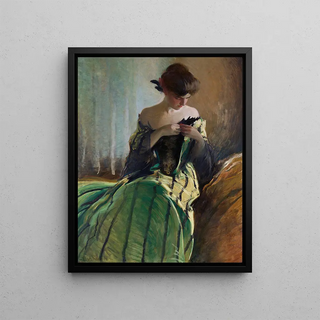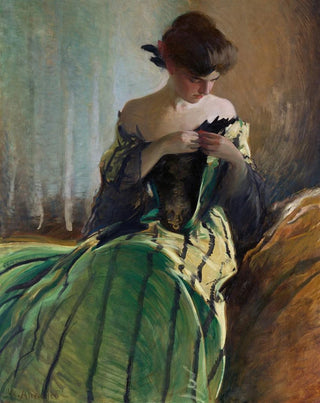Art print | Study in black and green - John White Alexander


View from behind

Frame (optional)
Art print Study in black and green - John White Alexander – Captivating introduction
In the fascinating universe of art, some works stand out for their ability to capture the essence of a period while evoking deep emotions. "Study in black and green - John White Alexander" is part of this tradition, offering the viewer an immersion into a world where color and form combine to create a unique atmosphere. This piece, which unfolds with palpable delicacy, invites attentive contemplation, gradually revealing its subtleties and nuances. Approaching this work, one immediately feels a connection with the artist's inner thoughts, a silent dialogue between the creator and the audience.
Style and uniqueness of the work
John White Alexander's work is characterized by a refined color palette and bold use of shadows. In "Study in black and green," the contrast between deep black and vibrant green creates a visual balance that draws the eye and stimulates the imagination. The forms intertwine gracefully, evoking a silent dance, where each element finds its place in a harmonious composition. This art print, beyond its aesthetic beauty, also questions the very nature of perception. The fluid lines and delicate textures seem to vibrate, giving life to a scene that, although frozen, breathes with palpable energy. Alexander, through his distinctive style, manages to transcend the simple frame of visual art to offer an enriching sensory experience.
The artist and his influence
John White Alexander, an emblematic figure of the American movement at the end of the 19th century, knew how to mark his era with his innovative approach and artistic sensitivity. Raised in an environment conducive to creativity, he developed a style that marries European influences and American traditions. His journey, marked by encounters with renowned artists, shaped his vision and technique. Alexander does not merely reproduce reality; he seeks to extract its essence, to capture the soul of the subjects he paints. His influence is felt beyond his works, touching many artists who see in him a model of boldness and finesse. "Study in black and green" embodies this quest for beauty and

Matte finish

View from behind

Frame (optional)
Art print Study in black and green - John White Alexander – Captivating introduction
In the fascinating universe of art, some works stand out for their ability to capture the essence of a period while evoking deep emotions. "Study in black and green - John White Alexander" is part of this tradition, offering the viewer an immersion into a world where color and form combine to create a unique atmosphere. This piece, which unfolds with palpable delicacy, invites attentive contemplation, gradually revealing its subtleties and nuances. Approaching this work, one immediately feels a connection with the artist's inner thoughts, a silent dialogue between the creator and the audience.
Style and uniqueness of the work
John White Alexander's work is characterized by a refined color palette and bold use of shadows. In "Study in black and green," the contrast between deep black and vibrant green creates a visual balance that draws the eye and stimulates the imagination. The forms intertwine gracefully, evoking a silent dance, where each element finds its place in a harmonious composition. This art print, beyond its aesthetic beauty, also questions the very nature of perception. The fluid lines and delicate textures seem to vibrate, giving life to a scene that, although frozen, breathes with palpable energy. Alexander, through his distinctive style, manages to transcend the simple frame of visual art to offer an enriching sensory experience.
The artist and his influence
John White Alexander, an emblematic figure of the American movement at the end of the 19th century, knew how to mark his era with his innovative approach and artistic sensitivity. Raised in an environment conducive to creativity, he developed a style that marries European influences and American traditions. His journey, marked by encounters with renowned artists, shaped his vision and technique. Alexander does not merely reproduce reality; he seeks to extract its essence, to capture the soul of the subjects he paints. His influence is felt beyond his works, touching many artists who see in him a model of boldness and finesse. "Study in black and green" embodies this quest for beauty and






